This an Argus Seventy-Five (originally called the Argoflex Seventy-Five) which is an inexpensive plastic bodied box camera made by Argus out of Ann Arbor, MI. Although it resembles a Twin Lens Reflex, it is still a box camera in that the camera has a fixed focus, and there isn’t actually a viewing lens like on a TLR. The top “lens” is just a clear piece of glass (or plastic) that reflects light off a mirror into a viewfinder on top of the camera. The camera has a single element lens, fixed focus, fixed aperture, and only one shutter speed. Despite these limitations, the camera is actually capable of taking decent shots on medium format film, certainly better quality than cheap “toy” Instamatic cameras that would become popular in the 1960s and 1970s.
Film Type: 620 (120 spools fit on the supply side only)
Lens: 75mm f/11 (estimated) Single Element Meniscus
Focus: Fixed Focus (7 ft to Infinity)
Type: Pseudo-TLR Box Camera
Shutter: Single Speed Metal Blade (Time and Inst only)
Speeds: Approximately 1/50th sec (Some say as slow as 1/30 and as fast as 1/60)
Exposure Meter: None
Battery: None
Manual: http://www.cameramanuals.org/argus/argus_75.pdf
History
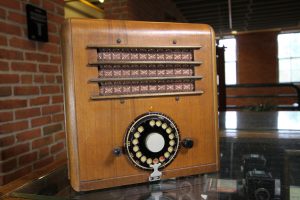
Argus was founded in 1931 as the International Radio Corporation, which produced several lines of radios known as the Kordette. IRC’s radio division was very profitable in the early part of the Great Depression. By the mid 1930s, the company’s profits began to slow down, so they began making cameras using their expertise at manufacturing inexpensive Bakelite consumer electronics.
Their plan worked, and the Argus A-series camera was an immediate success. Expanding into more advanced designs, Argus would release the C-series which would remain in production from 1938 all the way to 1966 making it one of the most popular American made cameras of all time.
With the success of the A and C-series, Argus wanted to add a medium format Twin Lens Reflex (TLR) camera to their lineup, so in 1940, they released the Argoflex Model E. Although given the name “Model E”, this was not displayed anywhere on the camera itself. Argus had developed an Argus Model D, but it never made it into production.
In 1940, the Argoflex Model E was released which had a Bakelite body like all other Argus cameras, and both f/4.5 taking and viewing lenses. Early versions were compatible with both 120 and 620 rollfilm, but later models would only accept 620 film, a trend which would continue through the rest of the Argoflex lineup.
This original Argoflex Model E would continue to be made until 1948, when 3 different models replaced it. All 3 of the new models dropped the Bakelite body in favor of an all new metal design. The Argoflex II was the most advanced, featuring an automatic film stop and frame counter, but it was poorly designed and often malfunctioned. As a result, it was taken off the market and is extremely rare today.
The Argoflex EM was also metal bodied and offered the same lenses, but lacked the Argoflex IIs automatic film stop and frame counter. The Model EF would be the same as the EM, except it had a flash sync port and accessory shoe on the side.
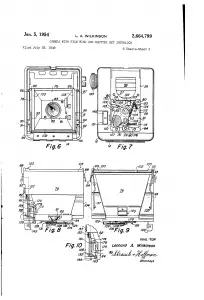
By 1951, perhaps due to slowing sales of TLR cameras, all metal bodied Argoflex cameras were discontinued and replaced by a much simpler Argoflex Forty. This new model had a smaller Bakelite body (although much different than the original Argoflex Model E), and lost the ability to focus the viewing lens.
As a result, all Argoflex models starting with the Forty and on, could no longer be called true TLR cameras. They were more like a box camera with a large viewfinder on top. You could not focus your image using the viewfinder, but instead would have to rely on scale focus like on simple viewfinder only cameras like the Argus A.
Around this same time, Argus also released an even simpler camera, known as the Argoflex Seventy-Five. On this camera, both the viewing and taking lenses were fixed in position meaning there was no way to focus the camera at all. The camera was aimed at the most basic photographer who needn’t be bothered by such annoyances like focusing an image.
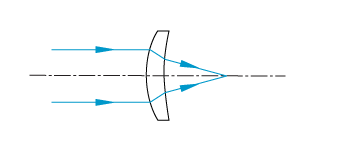
The Argoflex Seventy-Five camera had a single element positive meniscus lens that kept everything at 7 feet and beyond in focus. There was also no adjustable aperture or shutter speeds. The camera had a fixed aperture and single shutter speed which was estimated to be somewhere around 1/50th of a second, plus Bulb (incorrectly called ‘T’ mode on the camera) mode. The photographer would simply peer into the top viewfinder to compose their image and then press the shutter release button to capture the image. As long as there was sufficient light and the subject was more than 7 feet away, the image should come out properly focused and exposed. When new, the Argoflex Seventy-Five had an accessory “portrait” attachment that would slip over the taking lens reducing the focal distance to between 3 and 7 feet for closeups.
Sometime during the 1950s, the Argoflex name would be dropped, and the camera would be simply known as the Argus Seventy-Five. From 1954 to 1958 there was an Argus Super Seventy-Five which restored the taking lens ability to have adjustable focus, and added a slightly brighter 65mm f/8 lens. It was sold as an upgrade to the regular Seventy Five.
Despite having only a single shutter speed, 1/50th of a second was not as limiting as one might think. The Argus Seventy-Five user’s manual recommends the use of Kodak Verichrome and Kodacolor films. Wikipedia says that Verichrome Pan came in speeds of ISO 80 and 60 depending on whether it was daylight or tungsten balanced. In the 1950s, Kodacolor had a speed of ISO 32. These speeds are roughly close enough to a shutter speed of 1/50 sec to allow for the Sunny 16 rule for outdoor photography.
The fixed aperture has been estimated to be around f/11 (although Argus never advertised it as such) and that also jives well for average outdoor photography. Given the exposure latitude of slower films (especially B&W), being off by a stop or two isn’t a huge deal. Take any modern camera, set the lens to f/11 and the shutter speed to roughly the inverse of your film speed and blindly start shooting outdoors and the majority of your photos will come out properly exposed.
Using a fixed focus, single speed camera, with a single aperture might seem overly simple, and in a sense, it was. The camera was stripped of pretty much any possible way that a person would have to know anything about photography before taking a picture. This might seem like heresy to photographers who are used to manual control over everything, but surprisingly it worked pretty well. The Seventy-Five was produced for about 15 years, from 1949 – 1964. Exact production numbers are unknown (most Seventy-Fives were not even stamped with a serial number), but there had to be a lot of them made considering how often they come up for sale on eBay and at antique stores.
Today, aside from nostalgia, there is little demand for the Argus Seventy-Five. Many people have memories of their parents or grandparents shooting with an Argus Seventy-Five. They were very common back in the day, and rightfully so, they were extremely easy to use.
One of my favorite articles about this camera is this post on the Random Camera Blog which asks if the Argus 75 is a toy or a tool. I think that is a good question. In a sense, I think it can be both. This camera is so simple that even a child could use it, but it’s a real camera because it has all of the necessary parts to make a photograph. The single element meniscus lens is surprisingly capable of sharp details. Any type of medium format film, even on a cheap camera, is going to get you quite a bit of detail and excellent color rendition. Add to that the recent interest in “vintage” photography through smartphone apps, and lomography, the Argus 75 can still be used as a tool to capture some great shots. Sure, there will be some softness near the corners and some vignetting, but that’s an artistic choice that isn’t always bad.
Considering the massive supply of these out there and that the extremely simple design almost always still works, I highly recommend this camera to anyone looking for a unique camera experience.
My Thoughts
I received this camera in a ‘box o’ junk’ late in 2014. The camera sat in my garage for over 6 months before I even bothered to take a look at it.
Although the camera looked to be in good shape, it had a very musty smell to it, so I thought that maybe I could clean it up and get rid of the stink. Thankfully the Argus 75 is extremely easy to take apart. Remove 4 screws on the front plate and you already have access to the shutter. Remove 4 more on top and you can take off the viewfinder and strap.
I washed the strap in the laundry and used some mild soap and rubbing alcohol to wipe down the body and inside of the camera. The viewfinder mirror was in excellent shape and showed no signs of desilvering, so all I did was wipe it down with a soft cloth.
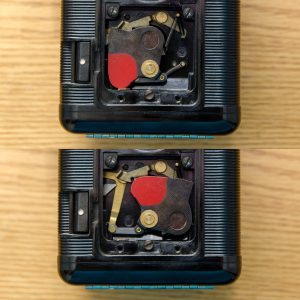
The shutter and aperture on the Argus 75 are incredibly simple. Since the aperture is not adjustable, there is simply a plastic plate with a small hole in it that is similar in size to an f/11 opening.
The shutter has two blades that function similar to a pair of scissors. When the shutter is not cocked, the second blade of the shutter covers the aperture hole (top picture to the left). When the shutter is cocked, both blades move together into a spring tensioned position. A portion of the first blade is painted red, which is where that red color comes from in the taking lens when the shutter is cocked (you can see this in the first picture at the top of this article).
When the shutter is fired, the first blade moves back to it’s original position first, and the film is exposed through the circular hole in the first shutter (you can clearly see this in the picture to the left). The second blade has an elongated hole which you cannot see in the image to the left, however this second blade lags behind the first shutter ever so slightly. During a short period of time (approximately 1/50th of a second), light can get through both the circular hole in the first blade, and the elongated hole in the second blade.
That is all there is to this shutter. There is nothing to clean, nothing to lube, and nothing to adjust. Frankly, barring physical damage or the spring breaking, I don’t see how any Argus 75 shutter could ever fail.
Looking at the Argus Seventy-Five, this camera is very clearly designed to appeal to someone who has no interest in photography other than capturing images. While it would be easy to dismiss this camera as a piece of junk, as I saw more and more results from it, I became intrigued about it’s use.
While yes, this camera is incredibly basic, therein lies the challenge. Can you still capture good shots within the limitations of one shutter speed, one aperture setting, and no focus ability?
The answer is an astounding yes!
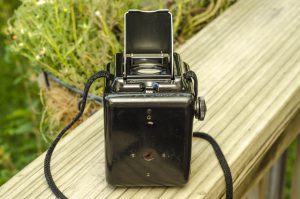
Using the Camera
Before you can shoot with an Argus Seventy-Five, you need to load film into it. As mentioned at the top of this article, the Argus Seventy-Five was designed for Kodak’s 620 film format which they almost exclusively used in the middle of the 20th century.
Sadly, today 620 film is no longer available, so you need to load 120 film into it. 120 film and 620 film are almost identical except for the spools. A 620 spool is both narrower and has a slightly smaller diameter than a 120 spool.
On other 620 cameras such as the Kodak Medalist, you need to either modify or re-spool 120 film onto a 620 spool. Thankfully, the Argus Seventy-Five isn’t as picky.
You can fit a normal 120 film spool on the supply (bottom) side of the camera, but you will still need a 620 spool on the takeup (top) side. If you are lucky, when you acquire an Argus Seventy-Five, the previous owner will have left an empty spool in the camera. If your camera came with film already in it, then you’ll have two, but you only need one. If you do not have any 620 spools, then you are out of luck because a 120 spool absolutely will not fit on the takeup side.
Load your 120 film and spool on the supply side like you would any camera. It will be snug, but it will fit. Put your blank 620 spool on the takeup side and thread the paper leader into the 620 spool like you would any other spool. Close the lid and turn the winding knob until you see the number 1 in the red window. The frame numbers on 120 paper line up perfectly with the position of the red window.
A word of caution. The red window on the Argus 75 does not have a door or any type of cover. It is always open to outside light. When this camera was designed, film speeds rarely exceeded ISO 100. If you load a fast film like 200, 400, or higher into your Argus, there is a very good chance that some light will leak through the red window onto the film and expose the film. My advice is to either stick to 100 speed film or slower, or if you are going to use faster film, use some black electrical tape to keep the red window covered while outdoors. Even with 100 speed film, pay special attention to not let direct sunlight hit that window. If you need to put the camera down while outside, put the red window facing down.
When you are ready to shoot with the camera, open the viewfinder, compose your image and shoot. The viewfinder on the Argus does not go through a ground glass or Fresnel screen. You are looking directly at the mirror, and as a result, the image is extremely bright and detailed. Its almost like looking through a window (but reversed). The image you see will be significantly brighter than anything you would see in a normal TLR.
Remember that there is no way to focus the camera. Argus says that everything 7 feet to infinity will be in focus. The viewfinder will not show out of focus images closer than 7 feet. If you put the camera 12 inches away from something and look through the viewfinder, it will appear in focus, but this is not how it will look on film. If you want to shoot something closer than 7 feet, you will need an accessory portrait lens.
This camera automatically cocks the shutter when you advance the film, and there is double exposure protection so you don’t even need to remember to advance the film after your previous shot. While this camera is extremely basic, Argus made sure to ‘idiot-proof’ it to make it appeal to anyone.
My Results
I chose to shoot Kodak Ektar 100 film for my first roll because ISO 100 speed is close enough to the approximate 1/50th second shutter speed to where it would be like using Sunny 16, but off one stop.
Sunny 16 says that if you use a shutter speed that is inverse to your film speed, bright sunlight will be f/16, hazy sun f/11, and average lighting f/8. Since the shutter speed is one stop slower than 1/100, I am off by one stop already. Since I cannot change the aperture, if I shoot in bright sunlight at f/11, I am off by another stop. So, I should expect to be 2 stops overexposed in bright sunlight, one stop in hazy sun, and right on in average lighting.
I’d say those assumptions are pretty spot on. Most of these examples were shot in bright sunlight. Although the flexibility of film masks the 2 stops overexposure a bit, you can still see some of the highlights are blown out. The first image, of the street scene was taken in shade, and that’s the only one that looks properly exposed. I did attempt to take 2 indoor photos on this roll, but neither of them came out, so I did not share them.
Despite the overexposure, I am very happy with how these shots came out. The meniscus lens is still capable of resolving a good level of detail, especially in the center of the image. Near the edges and corners, the image distorts showing a bit of chromatic aberration. This is just how single element lenses will look and is part of the “look” of the photos that this camera will give you.
Something I noticed which I am not sure is normal for all Argus Seventy-Fives or just mine, is that at 7 feet, the images are not really in sharp focus. The images of the boy sitting in front of the flowers and the lady holding the baby were shot at approximately 8 feet away, but if you look at the fine detail, they are not as sharp as the other images. I feel as though while 7 feet might be the minimum acceptable focus distance, for sharp focus, you want your subject to be at least 10 feet away.

Still, the colors are wonderful, the detail is good, and the soft look of the edges give these shots a really nice look to them. 120 film is still medium format and there is a lot of detail here. Any of these images could very well be easily blown up to a much larger size and would still look good.
One last observation of my first roll is that on many of the pictures, some of the black ink from the backing paper had rubbed off on the film itself. You can see smudges from the words KODAK and the frame numbers on some of the images. I am not sure if this is a result of shooting 120 film on a 620 spool, or if this is just a coincidence. I’ve never seen this happen on any roll film camera I’ve ever used, so perhaps something happened to the film between me shooting the pictures and it being developed.
| My Final Word | This is a cheap camera. It was meant to be cheap. It has one speed, one aperture, a single element lens, and can’t be focused. Yet, it somehow manages to be fun to use. Part of the appeal for me is figuring out ways to use this camera in spite of its limitations. While the images don’t compare to most other cameras, they do have a very specific look that can’t be duplicated on other cameras. These things are very inexpensive to buy, and despite it’s low rating, I still can recommend it to someone looking for a unique photographic challenge. | ||||||
| Images | Handling | Features | Viewfinder | Feel & Beauty | History | Age | |
| 0 | 2 | 0 | 0 | 0 | 0 | 30% | |
| Bonus | +1 for its incredibly simple, yet functional design, the Argus 75 is an early precursor to the point and shoot camera which requires little to know technical knowledge to use | ||||||
| Final Score | 3.6 | ||||||
Additional Resources
http://camera-wiki.org/wiki/Argus_Argoflex_Seventy-Five
http://randomphoto.blogspot.com/2009/01/argus-75-toy-or-tool.html
https://sites.google.com/site/fromthefocalplanetoinfinity/argus
http://junkstorecameras.com/Argoflex75.htm

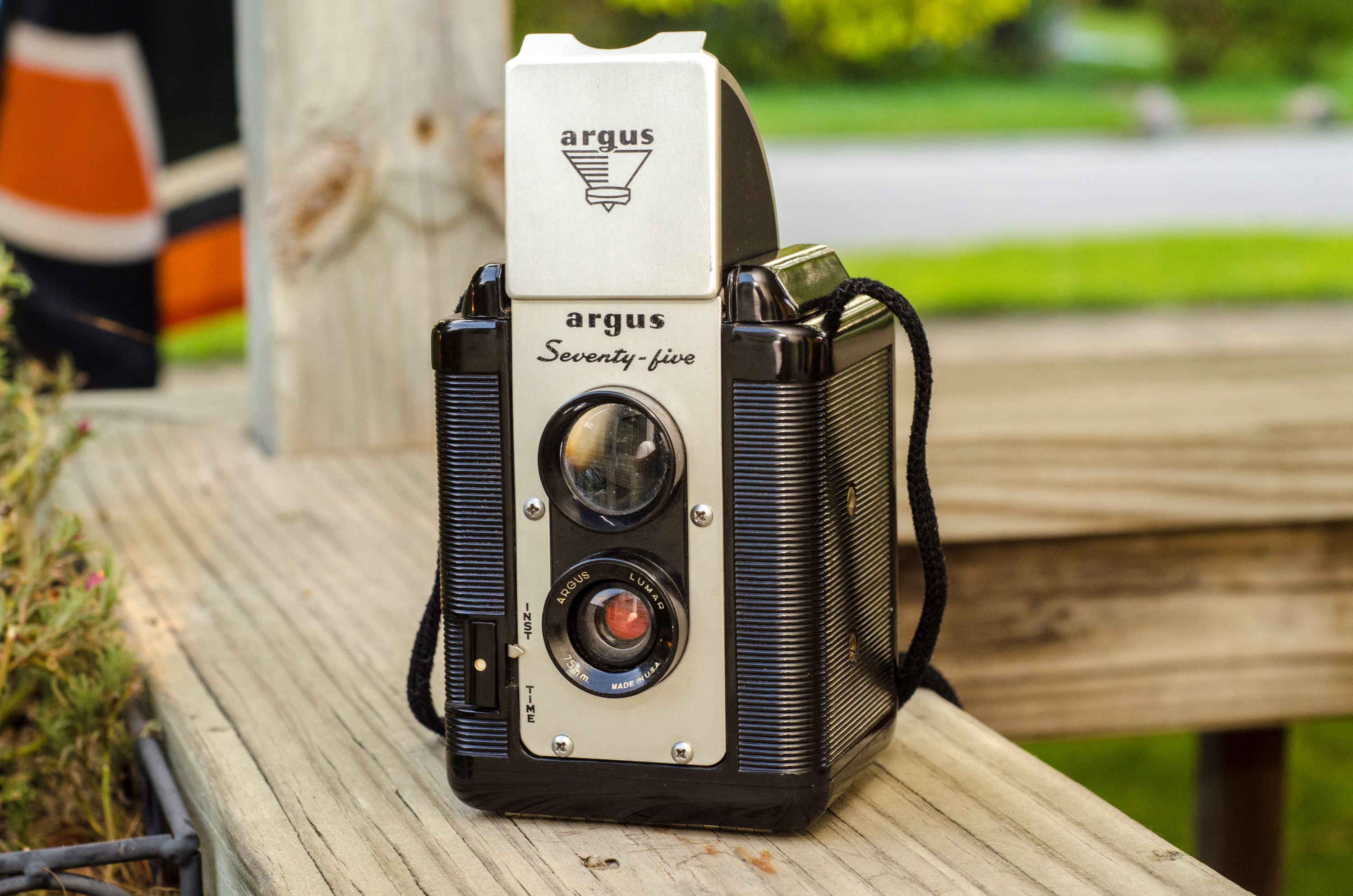
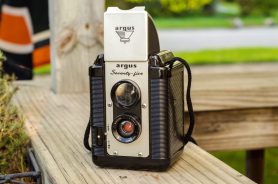
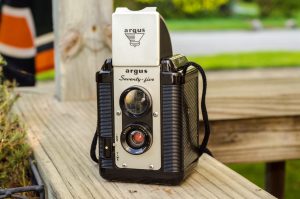






I have come upon an Argoflwx 75 from a deceased family member, I opened the back and there is film inside. Is there any way to get this film developed? I would love to see if there is anything on it!
Lisa, when you say that there was film still in the camera, was it already at the end of the spool, or could you actually see the film still loaded across the film plane somewhere in the middle of the roll? If it was at the end of the roll, the roll is likely sill salvageable. If it was mid roll, opening it like that exposed light to the film and it likely ruined at least a few images. Its still possible some of the early shots can be saved, but its doubtful.
Depending on the age of you film, you’ll want to send it to someone who specializes in old film. Dont just pick a local camera shop and send it to them. I recommend the Darkroom in San Clemente, CA. Contact them first and explain what you have and what kind of film it is, and they’ll give you a better idea if they can handle it.
I enjoyed your article. I picked up a Argus 75 and decided to give it a shot. I used Portra 160 film and took a few photos on a clear sunny day was quite impressed with the results. On the next outing it was overcast in a wooded park and the results were barely visable. Would you have any thoughts.
Hi David! I am glad to hear you gave your camera a shot. The reason you got underexposed shots using Kodak Portra 160 in poor lighting is that Portra isn’t fast enough to handle the light conditions. The Seventy-Five has a single shutter speed of about 1/50 second and a fixed aperture of about f/11. You’d need a camera with a much wider (faster) lens, or slower shutter speed to take advantage of heavily overcast light on that film. You could also try the camera’s Timed mode, in which you hold the shutter release down for as long as you want to keep the shutter open. This will require stablizing the camera on a flat surface though as any motion while the shutter is open, will blur your shots. Keeping it in instant mode, I would recommend going with a 400 speed film or faster if you want to keep shooting in low light, or just limit yourself to bright sunlit days.
If I could offer one more suggestion, which is if you really like the Seventy-Five, I would recommend you find an Argus/Argoflex Forty and give that a shot. It is a very similar camera, but with a faster (and sharper) f/4.5 lens, and a 4 speed shutter with speeds from 1/25 to 1/150 plus Bulb.
https://mikeeckman.com/2019/08/argoflex-forty-1950/
Thank you for the preview of the Argus 75. I just picked one up and excited to go out and shoot some. The Argus was used to photograph Patsy Cline at her last concert in 1963. Found some kodak 400 portra online $17! Wish me luck
Glad you liked the review Sam! These are simple, but capable cameras. I am sure you’ll be happy with the Kodak Portra in yours. Just remember to get a 620 spool or the film won’t advance properly.